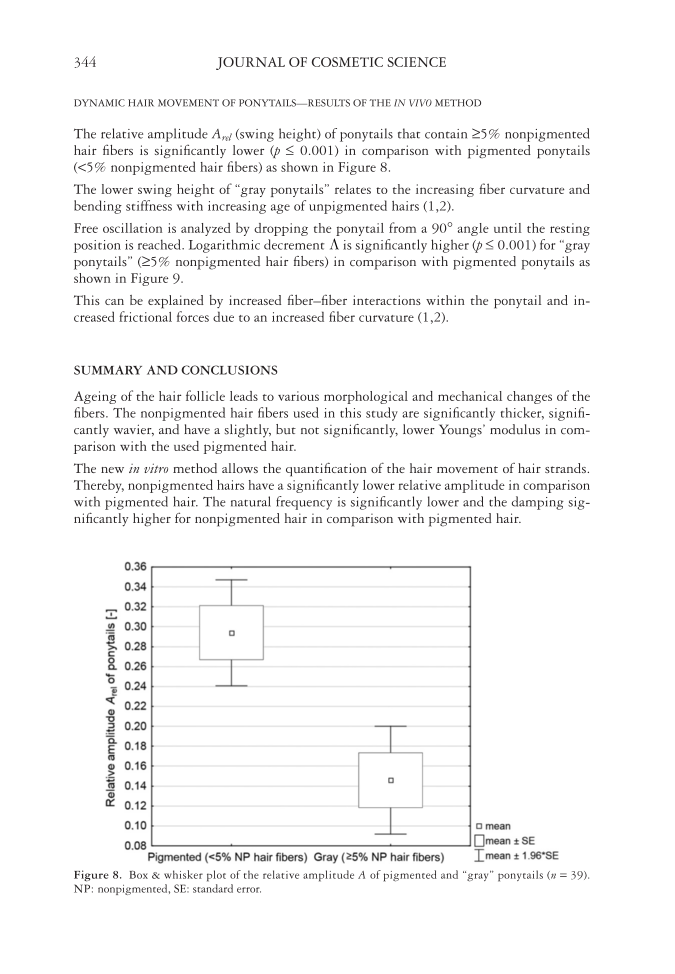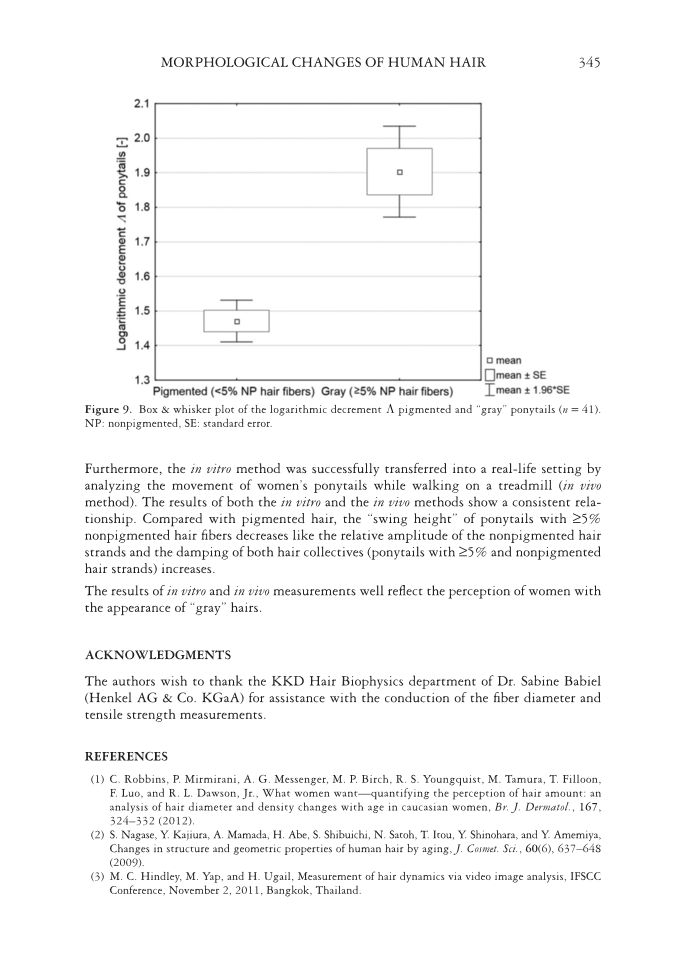JOURNAL OF COSMETIC SCIENCE 344 DYNAMIC HAIR MOVEMENT OF PONYTAILS—RESULTS OF THE IN VIVO METHOD The relative amplitude Arel (swing height) of ponytails that contain ≥5% nonpigmented hair fi bers is signifi cantly lower (p 0.001) in comparison with pigmented ponytails ( 5% nonpigmented hair fi bers) as shown in Figure 8. The lower swing height of “gray ponytails” relates to the increasing fi ber curvature and bending stiffness with increasing age of unpigmented hairs (1,2). Free oscillation is analyzed by dropping the ponytail from a 90° angle until the resting position is reached. Logarithmic decrement - is signifi cantly higher (p 0.001) for “gray ponytails” (≥5% nonpigmented hair fi bers) in comparison with pigmented ponytails as shown in Figure 9. This can be explained by increased fi ber–fi ber interactions within the ponytail and in- creased frictional forces due to an increased fi ber curvature (1,2). SUMMARY AND CONCLUSIONS Ageing of the hair follicle leads to various morphological and mechanical changes of the fi bers. The nonpigmented hair fi bers used in this study are signifi cantly thicker, signifi - cantly wavier, and have a slightly, but not signifi cantly, lower Youngs’ modulus in com- parison with the used pigmented hair. The new in vitro method allows the quantifi cation of the hair movement of hair strands. Thereby, nonpigmented hairs have a signifi cantly lower relative amplitude in comparison with pigmented hair. The natural frequency is signifi cantly lower and the damping sig- nifi cantly higher for nonpigmented hair in comparison with pigmented hair. Figure 8. Box & whisker plot of the relative amplitude A of pigmented and “gray” ponytails (n = 39). NP: nonpigmented, SE: standard error.
MORPHOLOGICAL CHANGES OF HUMAN HAIR 345 Furthermore, the in vitro method was successfully transferred into a real-life setting by analyzing the movement of women’s ponytails while walking on a treadmill (in vivo method). The results of both the in vitro and the in vivo methods show a consistent rela- tionship. Compared with pigmented hair, the “swing height” of ponytails with ≥5% nonpigmented hair fi bers decreases like the relative amplitude of the nonpigmented hair strands and the damping of both hair collectives (ponytails with ≥5% and nonpigmented hair strands) increases. The results of in vitro and in vivo measurements well refl ect the perception of women with the appearance of “gray” hairs. ACKNOWLEDGMENTS The authors wish to thank the KKD Hair Biophysics department of Dr. Sabine Babiel (Henkel AG & Co. KGaA) for assistance with the conduction of the fi ber diameter and tensile strength measurements. REFERENCES (1) C. Robbins, P. Mirmirani, A. G. Messenger, M. P. Birch, R. S. Youngquist, M. Tamura, T. Filloon, F. Luo, and R. L. Dawson, Jr., What wom en want—quantifying the perception of hair amount: an analysis of hair diameter and density changes with age in caucasian women, Br. J. Dermatol., 167, 324–332 (2012). (2) S. Nagase, Y. Kajiura, A. Mamada, H. Abe, S. Shibuichi, N. Satoh, T. Itou, Y. Shinohara, and Y. Amemiya, Changes in structure and geomet ric properties of human hair by aging, J. Cosmet. Sci., 60(6), 637–648 (2009). (3) M. C. Hindley, M. Yap, and H. Ugail, Measurement of hair dynamics via video image analysis, IFSCC Conference, November 2, 2011, Bangkok, Thailand. Figure 9. Box & whisker plot of the logarithmic decrement - pigmented and “gray” ponytails (n = 41). NP: nonpigmented, SE: standard error.
Purchased for the exclusive use of nofirst nolast (unknown) From: SCC Media Library & Resource Center (library.scconline.org)









































































































